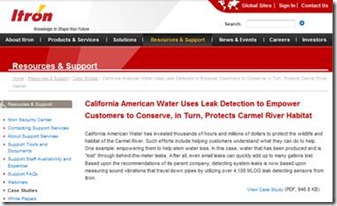With Concerns about Water Scarcity Growing, IT Solutions Are Proving Themselves in this Industry as Well
When I blogged about Severn Trent Water winning the Utility Company of the Year at the Utility Week Awards it served to spark my thinking on other water issues that are bubbling to the surface.
For instance, IDC Energy Insights, in its top 10 predictions for the utility sector in 2010, said their 8th prediction would be that “Scarcity of clean water and availability of new technology will awaken the sleeping water market.” IDC’s reasons? Water consumption risk is coming under scrutiny by financial investment community; there’s growing government, financial and public interest in sustainability issues; there are several pilot projects for smart metering and differentiated pricing; early implementations of sensors and networks for watershed management; and the tie between water and energy (energy to transport water, water to cool power plants). IDC predicted that:
· Increasing water rates will begin to provide a price signal that drives conservation initiatives and associated technology investments during the next 2-3 years
· Initial technology deployments will mimic electric utility investments by focusing on smart meters, two-way communications networks and analytics
· Outsourcing and build-operate-transfer (BOT) contracts will accelerate
· Industry fragmentation will continue to be the biggest challenge
All of these are interesting drivers and outcomes for the once-sleepy water utility industry.
They bring to mind an Itron case study I read recently. California American Water needed to reduce its draw from the Carmel River and locating leaks and lowering water losses was a clear way to achieve its goals. The case study noted that even small leaks can quickly add  up to many gallons lost. Just a 1/8-inch sized leak consumes more than 3,500 gallons per day of this precious resource. Solution? Itron’s MLOG, a network of intelligent, leak detecting sensors, or loggers, was used to monitor the entire water distribution system 365 days a year. Each night MLOG sensors analyze sound patterns in their environment, detecting new, evolving and pre-existing leaks automatically.
up to many gallons lost. Just a 1/8-inch sized leak consumes more than 3,500 gallons per day of this precious resource. Solution? Itron’s MLOG, a network of intelligent, leak detecting sensors, or loggers, was used to monitor the entire water distribution system 365 days a year. Each night MLOG sensors analyze sound patterns in their environment, detecting new, evolving and pre-existing leaks automatically.
By analyzing changes in the level and frequency of pipe sounds, MLOG creates a leak index for each MLOG sensor. Advanced analytical software displays potential leaks on detailed MLOG color map of the service area. Flexible reports facilitate management of each MLOG device, leak pinpointing and leak investigation. An expanding database of historical information allows water providers to track assets, account for lost water and guide maintenance of their water pipeline network. The information technology at the heart of the MLOG solution is based on Microsoft tools and SQL Server as ease of use, scalability and flexibility are key requirements for a leak detection system.
So while it’s tough to compare other utility industry dynamics to the extreme interest that exists around electric smart grid, the times they are a changing for water utilities. It’s clear information technology will be leading the way there as well!
- Jon C. Arnold, managing director, Microsoft Worldwide Power & Utilities Group